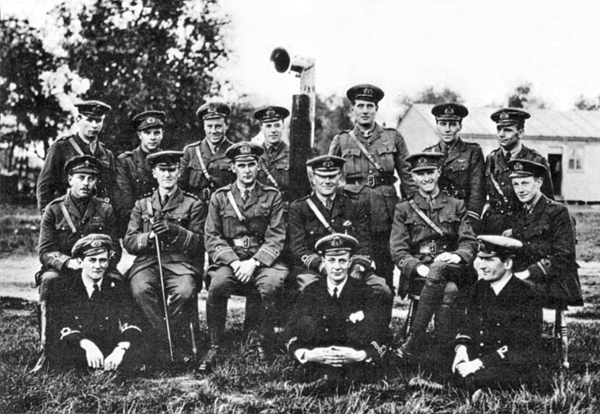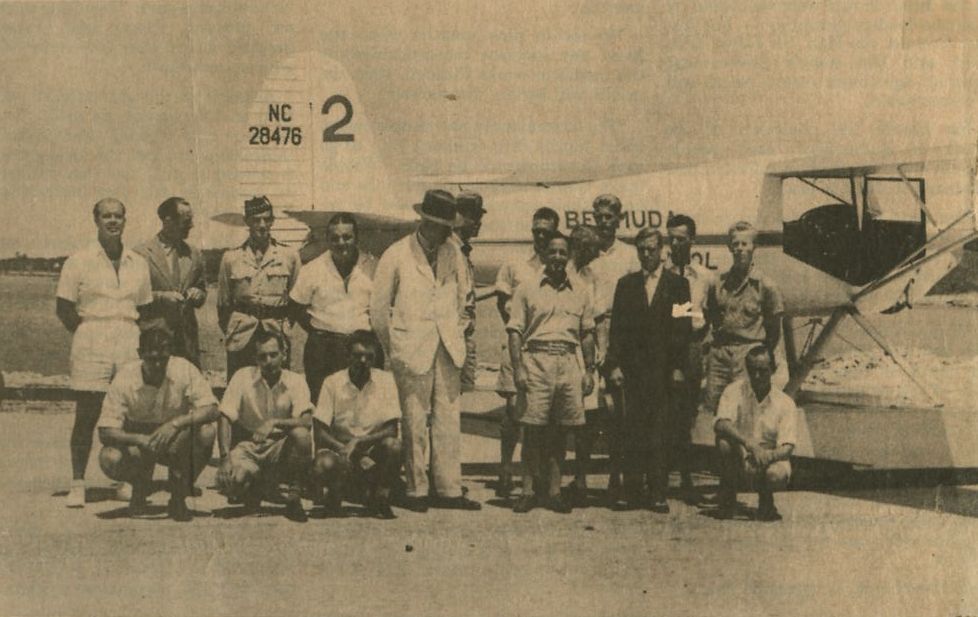|
Richard Gorham
Colonel Sir Richard Masters Gorham CBE, DFC, JP (3 October 1917 – 8 July 2006) was a prominent Bermudian parliamentarian, businessman and philanthropist, who served as a pilot during the Second World War when he played a decisive role in the Battle of Monte Cassino, earning the Distinguished Flying Cross. Second World War Bermuda Volunteer Engineers Born in Pembroke, Bermuda, the son of Mr. and Mrs. A. J. Gorham, he enlisted in the Bermuda Volunteer Engineers in 1938. The unit was mobilised, along with the other part-time units of the Bermuda Garrison (the Bermuda Militia Artillery (BMA), Bermuda Volunteer Rifle Corps (BVRC), and the Bermuda Militia Infantry), when the Second World War was declared. As a corporal, he was attached to the signalling division at the Royal Naval Dockyard and earned a commission as a result of his saving an exercise when he suggested an emergency method of signalling visually to replace a broken wireless transmitter. Bermuda Militia A ... [...More Info...] [...Related Items...] OR: [Wikipedia] [Google] [Baidu] |
Pembroke, Bermuda
Pembroke Parish is one of the nine parishes of Bermuda. It is named after English aristocrat William Herbert, 3rd Earl of Pembroke (1580–1630). It occupies most of the short peninsula which juts from the central north coast of Bermuda's main island, and surrounds the city of Hamilton on three sides (the fourth being taken up by the shore of Hamilton Harbour). As such, its shape bears some passing resemblance to the county of Pembrokeshire in Wales. The peninsula juts into the eastern side of the Great Sound, the large expanse of water which dominates the geography of western Bermuda. In the east, Pembroke meets Devonshire Parish. As with most of Bermuda's parishes, it covers just over 2.3 square miles (about 6.0 km2 or 1500 acres). It had a population of 11,160 in 2016. Natural features in Pembroke include Spanish Point, and Point Shares, as well as numerous small islands off Point Shares. Other notable features of Pembroke include Fort Hamilton and Government House ... [...More Info...] [...Related Items...] OR: [Wikipedia] [Google] [Baidu] |
Corporal
Corporal is a military rank in use by the armed forces of many countries. It is also a police rank in some police services. The rank is usually the lowest ranking non-commissioned officer. In some militaries, the rank of corporal nominally corresponds to commanding a Section (military unit), section or squad of soldiers. The word is a contraction from the Italian language, medieval Italian phrase ( [of soldiers]). While most Indo-European languages use this contraction, West Iberian languages use . Types * Lance corporal * * Corporal first class, First corporal * Second corporal * Master corporal * Corporal major * Corporal of horse * Corporal of the field * Staff corporal By country Australia Corporal is the second lowest of the non-commissioned officer ranks in the Australian Army, falling between lance-corporal and sergeant. A corporal is usually appointed as a section commander, and is in charge of 7–14 soldiers of private rank. They are assisted by a second-in ... [...More Info...] [...Related Items...] OR: [Wikipedia] [Google] [Baidu] |
Fleet Air Arm
The Fleet Air Arm (FAA) is the naval aviation component of the United Kingdom's Royal Navy (RN). The FAA is one of five :Fighting Arms of the Royal Navy, RN fighting arms. it is a primarily helicopter force, though also operating the Lockheed Martin F-35 Lightning II, F-35 Lightning II carrier-based stealth fighter jointly with the Royal Air Force. The RAF was formed by the 1918 merger of the RN's Royal Naval Air Service with the British Army's Royal Flying Corps. The FAA did not come under the direct control of the Admiralty (United Kingdom), Admiralty until mid-1939. During the Second World War, the FAA operated aircraft on ships as well as land-based aircraft that defended List of Royal Navy shore establishments, the Royal Navy's shore establishments and facilities. History Beginnings British naval flying started in 1909, with the construction of an airship for naval duties. In 1911 the Royal Navy graduated its first aeroplane pilots at the Royal Aero Club RAF Eastchu ... [...More Info...] [...Related Items...] OR: [Wikipedia] [Google] [Baidu] |
Royal Naval Air Service
The Royal Naval Air Service (RNAS) was the air arm of the Royal Navy, under the direction of the Admiralty (United Kingdom), Admiralty's Air Department, and existed formally from 1 July 1914 to 1 April 1918, when it was merged with the British Army's Royal Flying Corps to form the Royal Air Force (RAF), the world's first independent air force. It was replaced by the Fleet Air Arm, initially consisting of those RAF units that normally operated from ships, but emerging as a separate unit similar to the original RNAS by the time of the Second World War. History Background On 21 July 1908 Captain Reginald Bacon, who was a member of the Aerial Navigation Sub-Committee, submitted to the First Sea Lord John Fisher, 1st Baron Fisher, Sir John Fisher that a rigid airship based on the Imperial Germany, German Zeppelin be designed and constructed by the firm of Vickers. After much discussion on the Committee of Imperial Defence the suggestion was approved on 7 May 1909. Though Bacon ... [...More Info...] [...Related Items...] OR: [Wikipedia] [Google] [Baidu] |
First World War
World War I or the First World War (28 July 1914 – 11 November 1918), also known as the Great War, was a World war, global conflict between two coalitions: the Allies of World War I, Allies (or Entente) and the Central Powers. Fighting took place mainly in European theatre of World War I, Europe and the Middle Eastern theatre of World War I, Middle East, as well as in parts of African theatre of World War I, Africa and the Asian and Pacific theatre of World War I, Asia-Pacific, and in Europe was characterised by trench warfare; the widespread use of Artillery of World War I, artillery, machine guns, and Chemical weapons in World War I, chemical weapons (gas); and the introductions of Tanks in World War I, tanks and Aviation in World War I, aircraft. World War I was one of the List of wars by death toll, deadliest conflicts in history, resulting in an estimated World War I casualties, 10 million military dead and more than 20 million wounded, plus some 10 million civilian de ... [...More Info...] [...Related Items...] OR: [Wikipedia] [Google] [Baidu] |
Royal Flying Corps
The Royal Flying Corps (RFC) was the air arm of the British Army before and during the First World War until it merged with the Royal Naval Air Service on 1 April 1918 to form the Royal Air Force. During the early part of the war, the RFC supported the British Army by artillery co-operation and photographic reconnaissance. This work gradually led RFC pilots into aerial battles with German pilots and later in the war included the strafing of enemy infantry and emplacements, the bombing of German military airfields and later the strategic bombing of German industrial and transport facilities. At the start of World War I the RFC, commanded by Brigadier-General Sir David Henderson, consisted of five squadrons – one observation balloon squadron (RFC No 1 Squadron) and four aeroplane squadrons. These were first used for aerial spotting on 13 September 1914 but only became efficient when they perfected the use of wireless communication at Aubers Ridge on 9 May 1915. Ae ... [...More Info...] [...Related Items...] OR: [Wikipedia] [Google] [Baidu] |
Cecil Montgomery-Moore
Major Cecil Montgomery-Moore DFC (1 July 1899 – 8 December 1970) was an American-born Bermudian First World War fighter pilot, and commander of the Bermuda Volunteer Engineers and the Bermuda Flying School during the Second World War. Early life Montgomery-Moore was born in Chicopee, Massachusetts in 1899, to Alexander Acheson Montgomery-Moore, who was born in Waterford, Ireland and moved to the United States in 1890, and Lillian Webber Montgomery-Moore, born in New Hampshire. The family moved to the Imperial fortress colony of Bermuda in 1909. First World War During the First World War, Cecil Montgomery-Moore was an enlisted man in the Bermuda Volunteer Rifle Corps, attesting on 10 September 1915 (from 1 July 1910 to 10 September 1915, he had served in the Bermuda Cadet Corps). He was given leave to travel to Canada to join the Royal Flying Corps (RFC), air wing of the British Army, one of twenty or so Bermudians who did so during that war, and was discharged from the BVRC ... [...More Info...] [...Related Items...] OR: [Wikipedia] [Google] [Baidu] |
Army Council (1904)
The Army Council was the supreme administering body of the British Army from its creation in 1904 until it was reconstituted as the Army Board in 1964. History The disastrous campaigns of the Crimean War led to the consolidation of all administrative duties in 1855 under the Secretary of State for War, a Cabinet post. That office was not, however, solely responsible for the Army; the Commander-in-Chief (C-in-C) held a virtually equal level of responsibility. This was reduced in theory by the 1870 reforms introduced by Edward Cardwell, which subordinated the C-in-C to the Secretary for War. In practice, however, a huge amount of influence was retained by the exceedingly conservative C-in-C Field Marshal Prince George, 2nd Duke of Cambridge, who held the post between 1856–1895. His resistance to reform caused military efficiency to lag well behind Britain's rivals, a problem which became painfully obvious during the Second Boer War. The situation was only remedied in 1904 ... [...More Info...] [...Related Items...] OR: [Wikipedia] [Google] [Baidu] |
Royal Air Force
The Royal Air Force (RAF) is the Air force, air and space force of the United Kingdom, British Overseas Territories and Crown Dependencies. It was formed towards the end of the World War I, First World War on 1 April 1918, on the merger of the Royal Flying Corps (RFC) and the Royal Naval Air Service (RNAS). Following the Allies of World War I, Allied victory over the Central Powers in 1918, the RAF emerged as the largest air force in the world at the time. Since its formation, the RAF has played History of the Royal Air Force, a significant role in Military history of the United Kingdom, British military history. In particular, during the Second World War, the RAF established Air supremacy, air superiority over Nazi Germany's Luftwaffe during the Battle of Britain, and led the Allied strategic bombing effort. The RAF's mission is to support the objectives of the British Ministry of Defence (United Kingdom), Ministry of Defence (MOD), which are to "provide the capabilities nee ... [...More Info...] [...Related Items...] OR: [Wikipedia] [Google] [Baidu] |
Bermuda Flying School
The Bermuda Flying School operated on Darrell's Island from 1940 to 1942. It trained Bermudian volunteers as pilots for the Royal Air Force and the Fleet Air Arm. During the First World War, roughly twenty Bermudians had entered the Royal Flying Corps and its successor, the Royal Air Force (RAF), as aviators and many others as groundcrew. Other than aircraft on visiting ships, there were no aircraft based in Bermuda 'til after the war, when returning military aviators, Majors Hal Kitchener (son of the late governor, Lieutenant-General Sir Frederick Walter Kitchener, and nephew of Field Marshal Earl Kitchener) and Hemming, created a small company offering local flights in sea planes operating from Hinson's Island. In 1936, Imperial Airways built an air station on Darrell's Island. This operated as a staging point on scheduled trans-Atlantic flights by flying boats of Imperial Airways and Pan American. At the time, no land planes could operate from Bermuda, there being no airfie ... [...More Info...] [...Related Items...] OR: [Wikipedia] [Google] [Baidu] |


